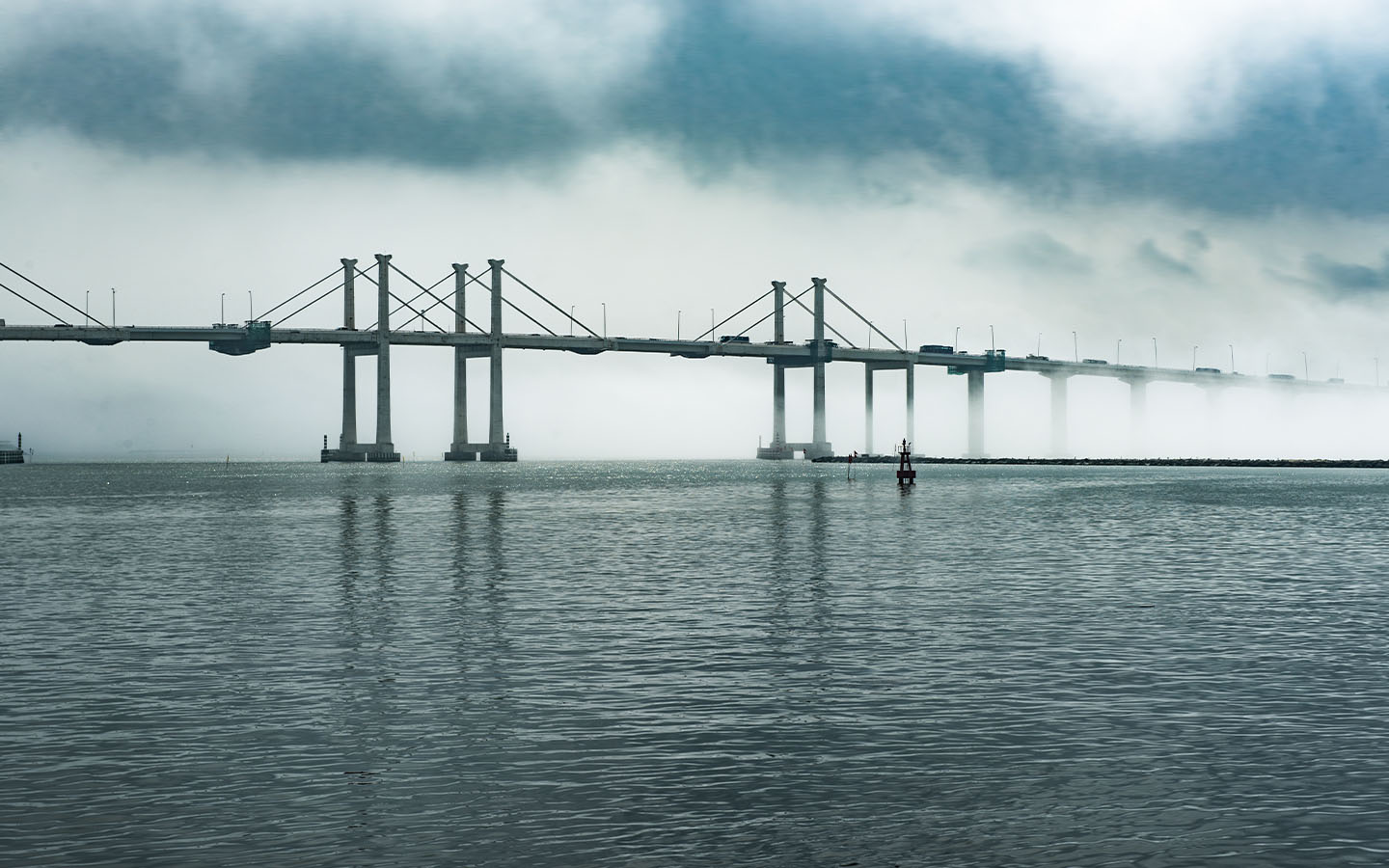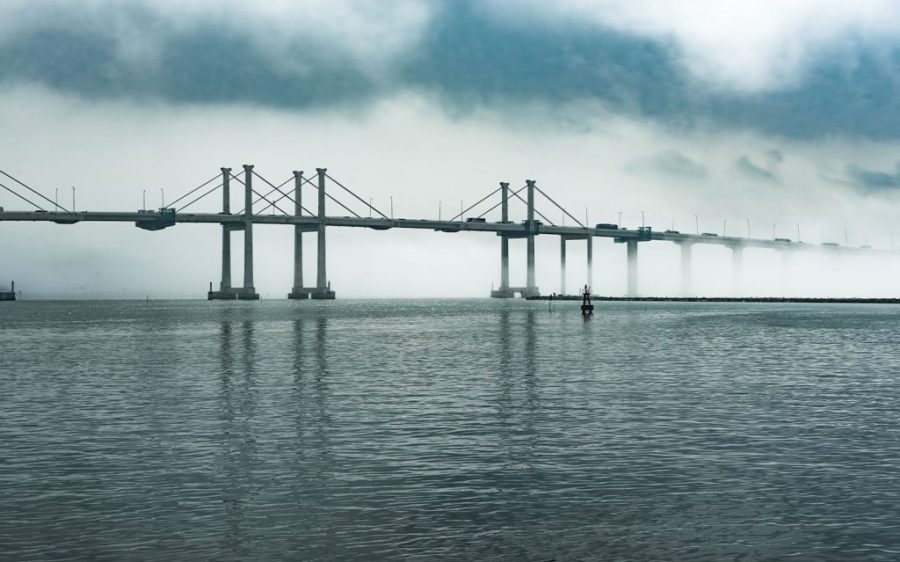Ferocious winds and driving rain are pummeling Macao as Super Typhoon Ragasa – the most powerful storm to have formed anywhere in the world this year – passes worryingly close to Macao after battering the northern Philippines and Taiwan.
Packing sustained wind speeds of 220 km/h, Ragasa will skirt Macao within a distance of 100 kilometres and make landfall on the west coast of Guangdong later today.
The Meteorological and Geophysical Bureau (known by the Portuguese initials SMG) is warning of hurricane-force winds, heavy rain and flooding. Residents should shelter in place and call 999, 110 or 112 in the event of an emergency.
More information about what to do in the event of a typhoon can be found in Macao News’ Ultimate Macao Typhoon Survival Guide.
4:08 pm: We are wrapping our live coverage of Ragasa
Thanks for being with us today during our coverage of Ragasa and its impact on Macao. We are ending live coverage now, but you can keep visiting our home page, and our Instagram and Facebook accounts, for more developments. Stay safe meanwhile.
4:01 pm: No. 10 typhoon signal downgraded to no. 8
The SMG has lowered the no. 10 signal to no. 8, as Ragasa continues to move away from Macao. The storm has also weakened from a “super typhoon” to a “severe typhoon.
At 4 pm, Ragasa was estimated to be about 140 kilometres southwest of Macao, moving in a west-northwest direction toward the coast of western Guangdong province.
The SMG has not said when it will lower the no. 8 signal to no. 3 – a move that will trigger the gradual resumption of public transport and the reopening of city bridges. However, the observatory in neighbouring Hong Kong – some 60 kilometres from Macao – will consider doing so from 8 pm.
3:38 pm: Storm surge warning lowered to blue
The SMG has lowered the red storm surge warning to blue, meaning that flooding is no longer expected to exceed 0.5 metres above street level. Meteorologists say the water level is falling and will continue to do so.
If your home has been hit by floods, there are professional cleaning companies in Macao that can help with cleanup. While they may not all specialise exclusively in water damage restoration, many offer services like water removal, drying, disinfection, and basic repair work after flooding.
Companies such as Pro Cleaning Service, Easy Clean Cleaning Services, and others listed in local directories say they are equipped to handle residential and commercial post-flood cleaning.
3:02 pm: Hundreds of people remain in emergency shelters
Although Ragasa is moving further away from Macao, the city’s public shelters are busy, with 612 people seeking refuge according to the latest government bulletin.
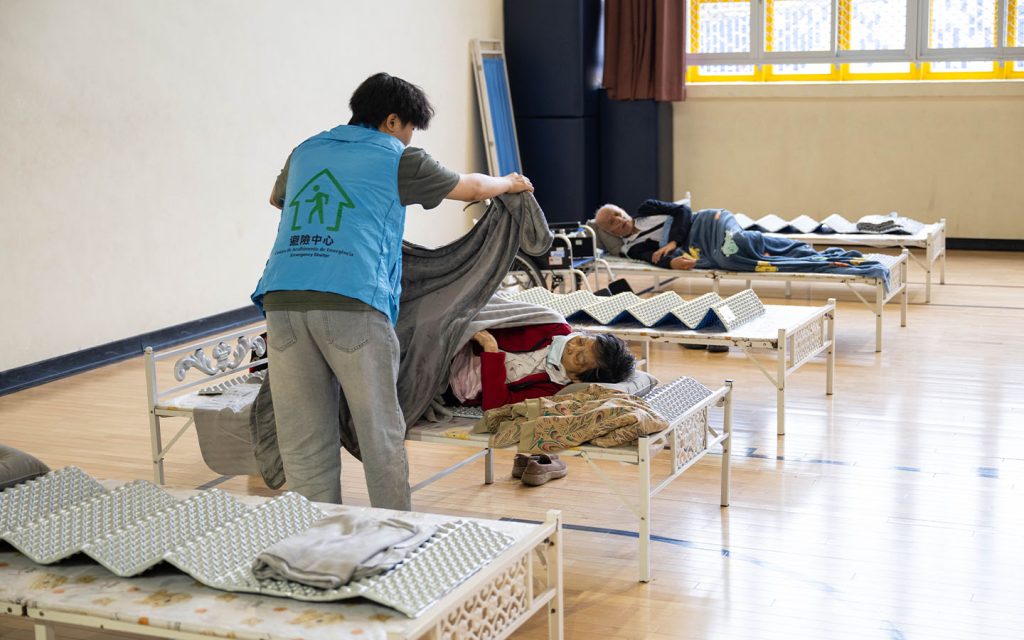
Miraculously, the storm appears to have caused few injuries: only 1 had been reported as of 2:15 pm. Three people were reported trapped in lifts and there have been dozens of reports of downed trees, lampposts and scaffolding, as well as damage to billboards, signage and other structures.
2:49 pm: Floods are slowly subsiding across Macao’s low-lying districts
The flooding in Macao’s low-lying areas is gradually easing off, with government measuring stations showing that the water level in these districts in now below 1 metre.
As of 2:25 pm, the water level in the Inner Harbour area stood at 0.54 metres. Stations at the Inner Harbour (North), Inner Harbour (South) and Largo do Pagode do Bazar recorded water levels of 0.48 metres, 0.24 metres and 0.28 metres respectively.
2:26 pm: Signal no. 10 to be lowered to no. 8 at 4 pm
In a bulletin issued at 2 pm, the SMG said that the present no. 10 typhoon signal will be lowered at 4 pm to a no. 8 signal. However, it warned that “Macao is still under the influence of the core circulation of Ragasa, with gale, heavy rain and thunderstorms. The public still needs to pay attention to the impact of the severe weather.”
At 2 pm, Super Typhoon Ragasa was estimated to be about 110 kilometres southwest of Macao and moving west-northwest toward the coast of western Guangdong.
Meanwhile, meteorologists in Hong Kong, where signal no. 8 is already in effect, said they would consider issuing the lower no. 3 signal at 8 pm or later.
2:17 pm: Damage to homes in Coloane
A reader has shared with Macao News this poignant image of the damage caused by flooding to her home in Coloane.
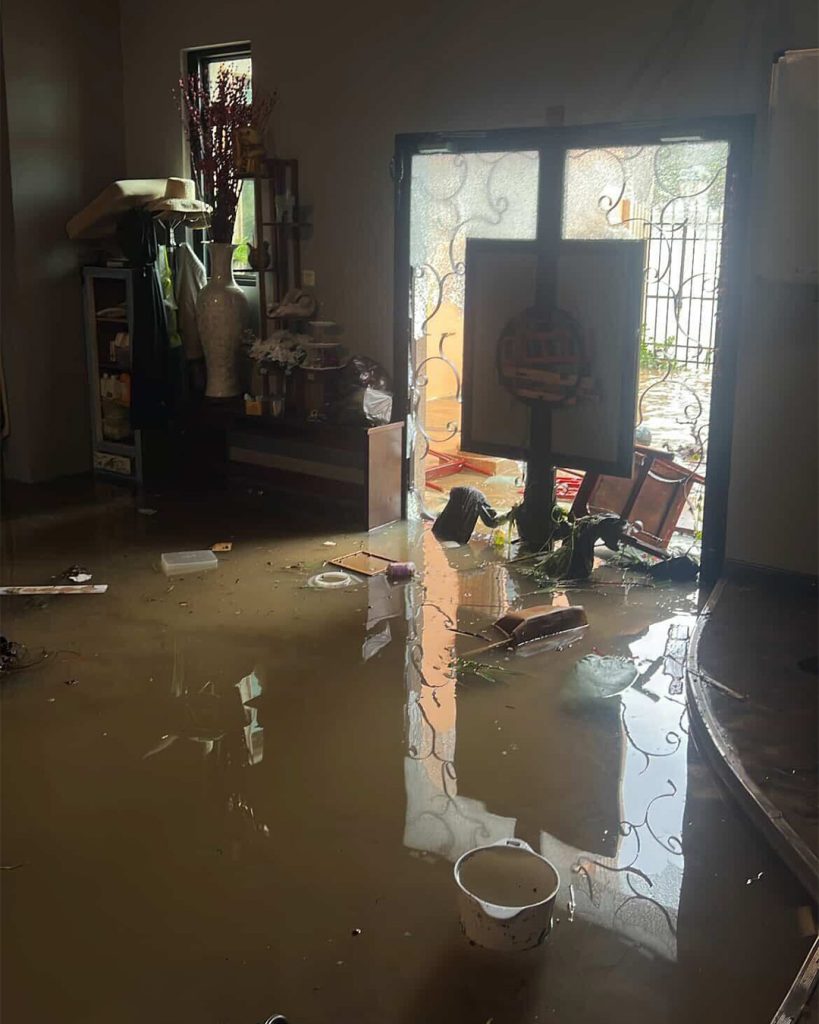
“This started at around 10:30 am,” she tells Macao News. “We are safe,” she continued, adding that “Right now, the water has gone down.”
1:51 pm: See the dramatic video of floodwaters crashing into a Hong Kong hotel
The moment when waves crashed into the Fullerton Ocean Park Hotel this morning was captured by a lobby bystander. The waters knock a guest off his feet and swept him across the lobby.
The hotel told the South China Morning Post that no injuries were reported. “We have deployed additional resources and are doing all we can to mitigate the impact brought about by the super typhoon,” it said.
Daryl Ng, chairman of hotel owners Sino Group, told the paper: “We will rebuild and come back stronger.”
1:42 pm: No further power outages expected
In a statement posted at around 12:30 pm, Macao’s electricity provider, CEM, said it does not intend to “implement the next round” of precautionary power suspensions as water levels have not risen.
The firm said that it would quickly restore power to affected households once the typhoon signal falls below level 8.
1:32 pm: Rescuers use jet-skis to evacuate people from flood zones
A number of residents have to be rescued by local authorities as a result of the flooding that has swept Macao’s low-lying districts.
According to local media reports, two individuals around the Hong Kung Temple were transported to safety after Macao Customs officers, who were making a patrol on jet skis, found them in need of help.
In addition, the Public Security Police, Fire Service Bureau and Macao Customs also conducted a rescue operation to help 13 residents who were trapped by the floods in the area spanning Rua de Cinco de Outubro and Rua do Tarrafeiro. The operation lasted roughly an hour, with the authorities making use of life rafts and jet skis.
1:03 pm: Flooding in the Inner Harbour district
These images shared just minutes ago with Macao News show the extent of flooding on Rua do Almirante Sérgio, near Ponte 16.
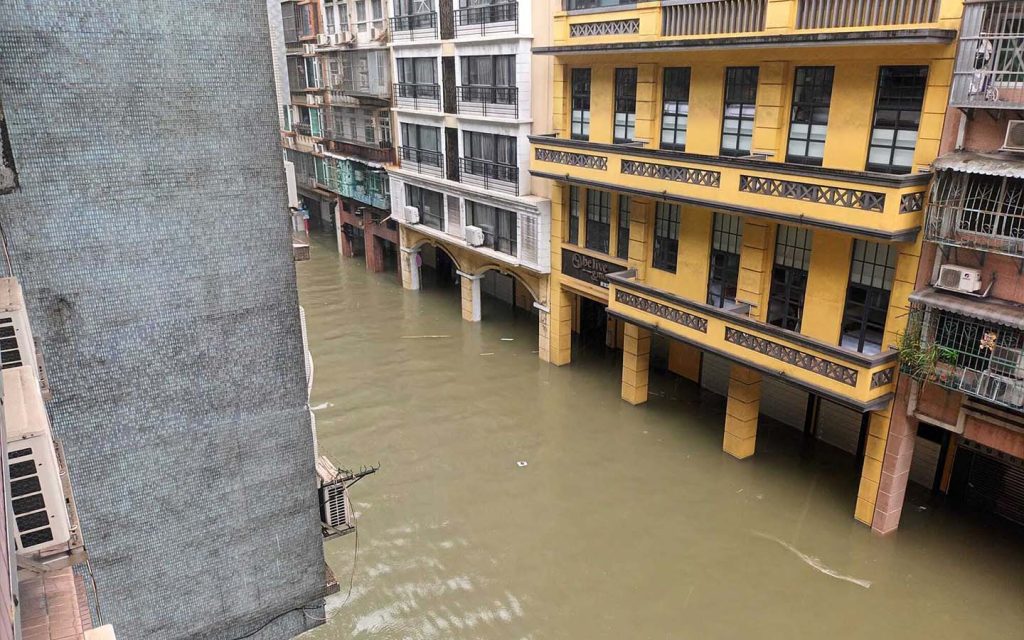
Power has been cut to the area and other low-lying parts of Macao, with an estimated 16,000 people currently without electricity.
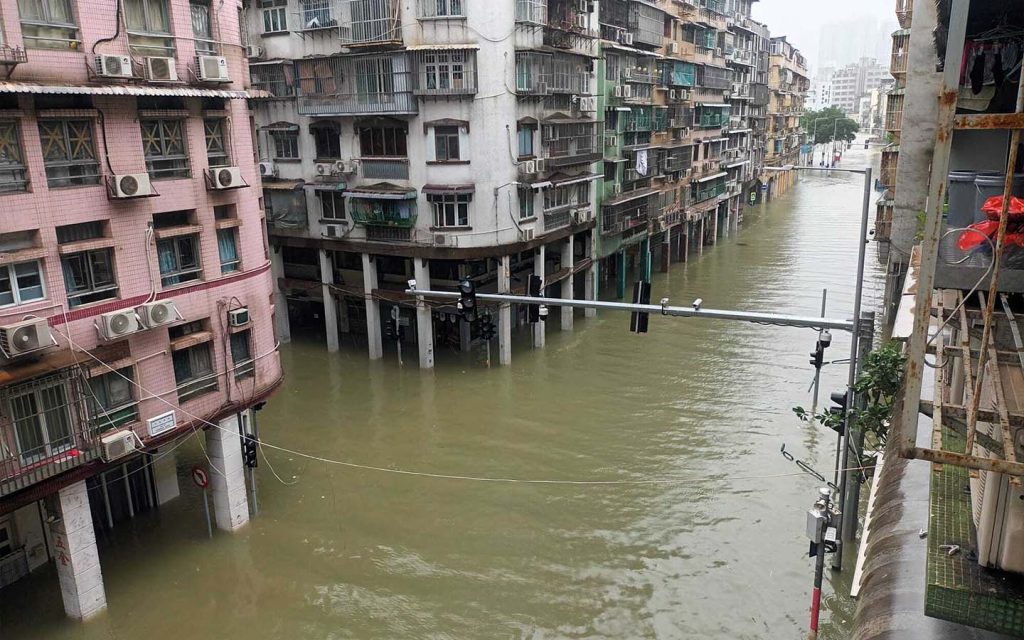
1:01 pm: Waves breaking over Governador Nobre de Carvalho Bridge approach road
Another picture shared from an Ocean Gardens resident captures the extent of the sea-level rise off the Taipa shoreline.
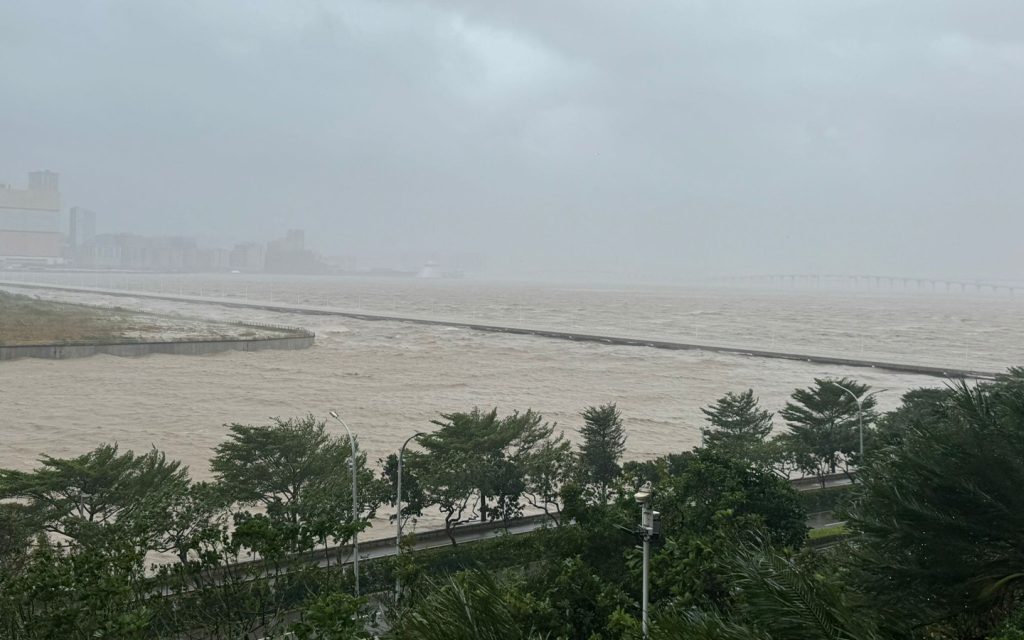
Land reclamation, to the left of the image, is in danger of submersion, while to the right waves have broken over the approach road of the Governador Nobre de Carvalho Bridge.
12:52 pm: Hengqin ravaged by strong winds and flooding
In a statement published at 12:05 pm today, the Hengqin authorities noted that the Hengqin Bridge had been hit by level 14 wind speeds. Under China’s wind speed scale, level 14 indicates gale force winds of 150 to 166 kilometres per hour.
Other parts of the island, including Hengqin Wetland Park and the south of the Changwan Tunnel, faced level 12 winds that had speeds of between 118 to 133 kilometres per hour.
Hengqin officials also said that large waves had swept the coast of the city, with some roads inundated by sea water.
12:43 pm: Hong Kong to lower signal 10 to signal 8 shortly
With Ragasa moving towards the coast of western Guangdong, and away from the Pearl River Delta, the Hong Kong Observatory says it will lower its current no. 10 signal to a no. 8 signal at 1:20 pm today.
So far, there has been no word on lowered signals from Macao’s SMG. In a bulletin issued at 12:15 pm, it merely noted that the no. 10 signal “will be in effect for a period of time.”
12:27 pm: Ragasa appears to be slowly moving away from Macao
The latest SMG chart appears to indicate that Ragasa has passed its closest point and is now starting to move away from Macao.
At 12 pm, the storm was estimated to be about 100 km south-southwest of Macao and forecast to move west-northwest at around 20 km/h toward the coast of western Guangdong.
According to the latest Civil Protection bulletins, there are currently 594 people in public shelters.
The reported damage so far includes 17cases of fallen trees and lampposts; 53 cases of damaged or fallen signboards, windows, and canopies; 4 cases of collapsed scaffolding and other construction facilities; 2 cases of persons trapped in a lift; and 7 fires.
So far, only one person has been reported injured as a result of the typhoon.
12:13 pm: More fishing, this time on Avenida do Almirante Lacerda
What do you do when the shops are closed in the typhoon and you need something for lunch? You go street fishing, of course.
A video being shared on social media appears to show a determined resident on the Avenida do Almirante Lacerda in hot pursuit of a fish.
Again, it’s not clear whether this fish is an escapee from a tank or if it came in on the storm surge, but one thing is sure: it’s going to be the subject of this fisherman’s brags for many years to come.
12:05 pm: Coloane inundated by floodwaters
Video being shared on the Facebook account Macau Dangerous Driving appears to show an inundated Coloane Village during the passage of Super Typhoon Ragasa.
Earlier today, Coloane’s Rua dos Hortelãos and the area around the Chapel of St. Francis Xavier were hit with water levels of 0.84 metres.
12:00 pm: Some 16,000 households have been affected by power outages
Speaking to local media less than an hour ago, the head of Macao’s electricity provider, CEM, said that around 16,000 households had been impacted by the power cut caused by Typhoon Ragasa. The company said it would quickly work to restore power as soon as the flooding had subsided.
Affected areas include Rua do Almirante Sérgio, Praça de Ponte e Horta, Rua da Praia do Manduco, Barra, Avenida de Almeida Ribeiro (San Ma Lo), Rua das Estalagens, Patane, Avenida do Almirante Lacerda, Rua da Doca do Lam Mau, Fai Chi Kei, San Kio and Rua da Emenda.
11:54 am: The road to the University of Macau has been closed
The road to the University of Macau has been sealed off after the authorities installed flood gates in the underground tunnel leading to the campus in Hengqin. That’s according to an official post made at approximately 11:30 am.
11:43 am: Water crashes through Hong Kong’s Fullerton hotel
Dramatic scenes in Hong Kong this morning, with multiple social media posts appearing to show stormwater crashing through the glass doors of the city’s upscale Fullerton Ocean Park Hotel and knocking a guest off his feet.
A total of 33 people have been reported injured in Macao’s neighbouring SAR as a result of the typhoon, the South China Morning Post reports. The injured include a woman and her young son, who are in intensive care after strong waves swept them into the sea yesterday.
11:33 am: Flooding is expected to peak at around noon
An advisory from the SMG says water levels are continuing to rise, with incoming seawater swelling storm runoff. Peak flooding is expected shortly, and officials say the possibility of a black storm surge warning – meaning that flood levels will exceed 2.5 metres – cannot be ruled out.
11:17 am: The Avenida de Almeida Ribeiro is flooded
A video being shared on social media appears to show Macao’s iconic thoroughfare Avenida de Almeida Ribeiro – colloquially known as San Ma Lo – completely flooded, along with the nearby Rua das Lorchas.
The recently restored Grande Hotel and the famous Lee Kum Kee shop (the pale yellow, low-rise building) can be respectively seen to the left and right of the initial frame.
Another video shared with Macao News just minutes ago shows the area behind the Grande Hotel, on the Rua do Visconde Paco de Arcos.
11:02 am: Power is now out in several areas of Macao
The latest bulletin from utility provider CEM says that with flooding now at 1.5 metres above street level, it has “implemented power suspension to the flood-affected areas to ensure public safety and to protect power supply facilities.”
CEM says that “When the water recedes, power restoration will be arranged as soon as possible. Please stay alert, prepare well, and continue to follow the news released by the Civil Protection Operations Centre and CEM.”
10:58 am: Water levels rising rapidly across low-lying areas
Water levels are swelling quickly in Macao’s low-lying districts, with official data revealing that the Inner Harbour measuring station had a reading of 1.31 metres at 10:48 am. Meanwhile, the readings at Praça de Ponte e Horta and Largo do Pagode do Bazar were 0.98 metres and 0.94 metres respectively.
As a result of the severe flooding, buildings in these low-lying areas have had their power temporarily cut off.
Parts of Taipa, such as Rotunda Ouvidor Arriaga, have also experienced flooding, according to local reports. Meanwhile, Coloane’s Rua dos Hortelãos and the area around the Chapel of St. Francis Xavier have been hit with water levels of 0.84 metres.
10:40 am: Rough seas seen from Taipa shoreline
A resident of Ocean Gardens sends this image taken from their apartment window of churning waters just off the northwest Taipa shoreline.
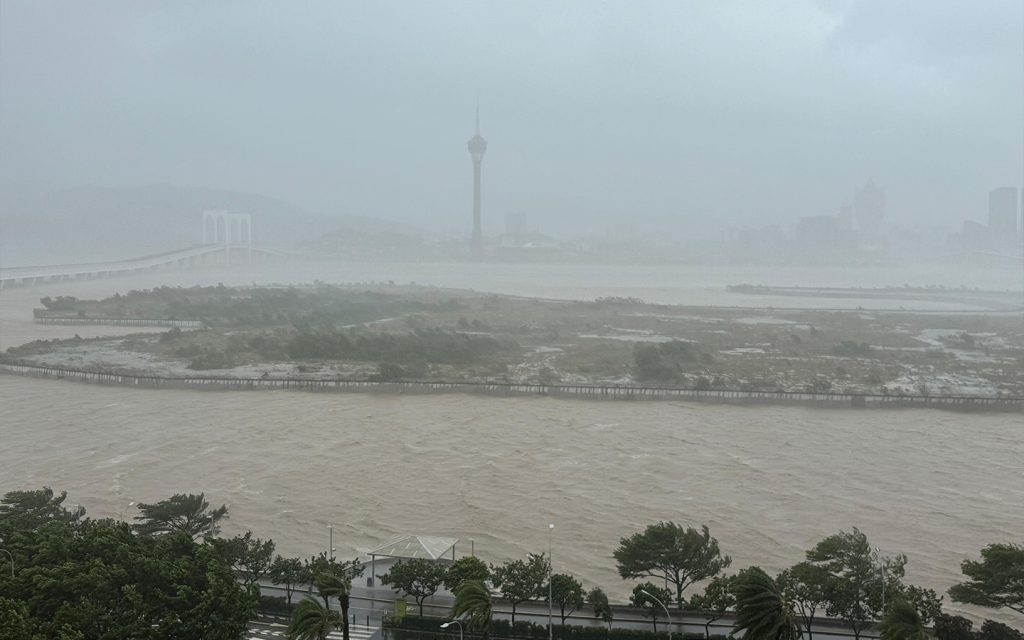
Trees can be seen bending in Ragasa’s gale-force winds, while Macau Tower and the peninsula are only faintly visible through the driving rain.
10:30 am: GBA cities shut down as Ragasa rages
According to Guangdong Emergency Management, 16 cities across Guangdong province have shut down normal operations, including schools, businesses and work.
Some of the major cities include Guangzhou, Shenzhen, Zhuhai, Foshan, Huizhou, Dongguan, Zhongshan and Jiangmen. In preparation for Ragasa’s arrival, Shenzhen evacuated some 400,000 people living in low-lying and coastal areas, as well as temporary shelters.
Evacuations have also taken place in Zhuhai, where authorities have confirmed that they have relocated residents living on the top floors of high rise buildings situated on Lover’s Road – an area that directly faces the sea.
Guangdong authorities remind residents to avoid venturing outdoors. In case of local emergencies, call 110, 119, 120 or 12345.
10:03 am: Over 2,400 evacuated
The commander of the Civil Protection Operations Centre, Wong Sio Chak, said the authorities had evacuated 2,439 people from 7,905 households as of 5 pm yesterday. Another 78 households, comprising 230 individuals, refused to be evacuated.
As of 10 am, a total of 640 people had made use of the government’s emergency shelters, according to the latest bulletin.
9:57 am: Fish are swimming down Inner Harbour Streets
Macao News’ Kenny Fong sends this photo from Rua do Dr. Lourenço Pereira Marques of a man catching a fish on the road a short while ago. It isn’t clear whether the fish is an escapee from a tank or one that swam in on a storm surge.

Images taken at the same location show that the flooding hasn’t started in earnest, but authorities are taking no chances.
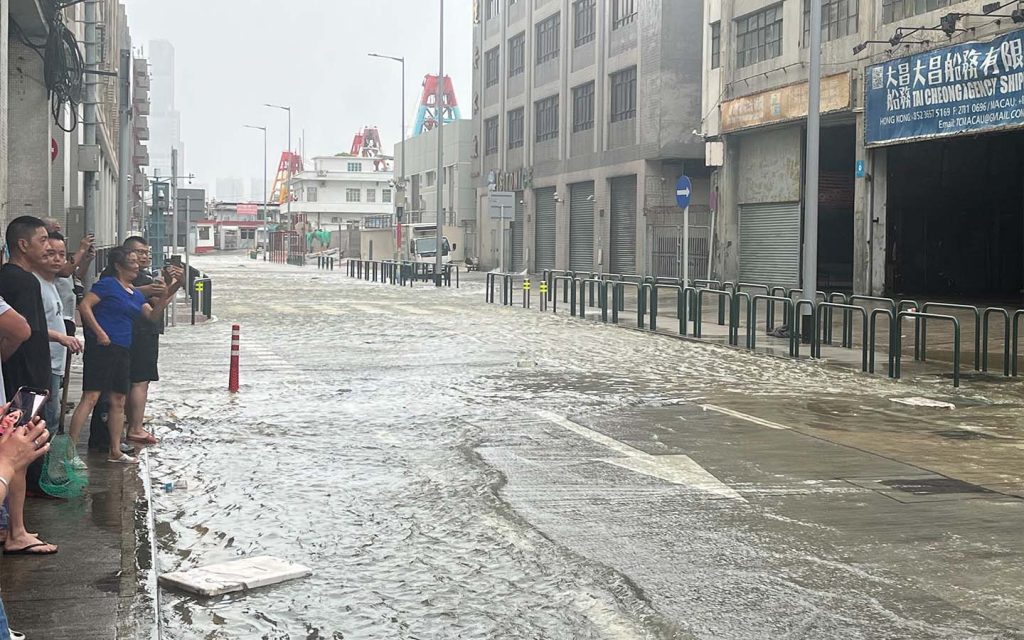
9:43 am: CEM will cut power to low-lying areas soon
This advisory has been posted to the Typhoon and Civil Defense Information account on Facebook:
“According to Macau Electricity Company Limited (CEM), water levels continue to rise due to the typhoon and storm surge. To ensure public safety and protect power supply facilities, power outages may occur in low-lying areas over the next 1 to 2 hours. The affected areas primarily include the Inner Harbour, Praça de Ponte e Horta, A-Ma Temple, Rua da Praia do Manduco and Patane. CEM will continue to monitor the situation and provide the public with the latest information on power outages as appropriate. Please pay close attention and prepare in advance.”
If you’re in one of the affected areas, this would be a good time to charge your mobile phone, so you can keep abreast of typhoon news even after the power outage.
9:25 am: Current position of Super Typhoon Ragasa
At 9 am, Super Typhoon Ragasa was estimated to be about 100 kilometres south of Macao and forecast to move west-northwest at around 20 km/h. It will gradually edge closer to Macao in the next hour or two before veering off to the west Guangdong coast.
On its present track, it looks to be making landfall somewhere near Yangjiang, a city of about 2.7 million people about 195 kilometres from Macao.
9:23 am: A reminder that the Sai Van Bridge lower deck is closed
The enclosed lower deck of the Sai Van Bridge – normally the only conduit between the peninsula and Taipa during severe weather – has closed with the no. 10 typhoon signal in force. This means that Taipa and Coloane are effectively cut off from the rest of the city.
8:35 am: Buildings sway as Ragasa pounds neighbouring Hong Kong
High rise dwellers in Hong Kong – about 60 kilometres from Macao have reported swaying buildings as Ragasa’s fierce winds pummel the city. “My flat is shaking,” according to one Facebook user quoted by the South China Morning Post.
Others have been unsettled by the howling gales. “It is terrifying. In all my years living here, I’ve never felt this scared … my palms are literally sweating,” said one resident of the city’s northern suburbs.
Macao’s neighbouring SAR has issued a flood warning, with sea levels and water in local rivers rising sharply.
8:15 am: Casinos deserted amid fifth full shutdown
Local authorities ordered all casinos in Macao to close at 5 pm last night in preparation for Ragasa’s arrival.
Asia Gaming Brief notes that this is the fifth full shutdown of casinos in the city’s history. The first took place for 33 hours during the passage of Typhoon Mangkhut in 2018. Other closures followed during the Covid-19 pandemic, when gambling halls casinos were shut for 15 days in February 2020 and one week in July 2022. Typhoon Saola (2023) led to a nine-hour closure.
8:04 am: Shelter in place and stay away from windows
A Civil Protection bulletin has appealed to residents and visitors to “stay away from windows and not go outside.”
Officials warn that “Wind speeds are expected to increase rapidly, potentially reaching hurricane force 12 or above. Water levels are also beginning to rise gradually. All residents and tourists are urged to heighten their vigilance, not to go outside, and remain indoors in a safe place.”
The communique advises that “There is a risk of windows shattering due to strong winds; stay away from windows.”
7:50 am: Hundreds are seeking shelter in public refuges
According to government figures, there are currently 579 people waiting out the storm in Macao’s public shelters.
If you need to seek refuge, the Macao government runs four emergency shelters during typhoons.
On the Macao peninsula, residents can go to the Ilha Verde Refuge Centre or the Macao Federation of Trade Unions Workers Stadium (by the Praça das Portas do Cerco).
People in Taipa can go to the Taipa branch of the Taipa and Coloane Social Service Centre, while those in Coloane can visit the Academy of Public Security Forces.
7:30 am: The no. 10 typhoon signal is in effect
Welcome to our live coverage of Super Typhoon Ragasa as it passes close to Macao.
The no. 10 typhoon signal was hoisted by the SMG at 5:30 am and is expected to remain in effect for some time. This is the highest signal in Macao’s warning system and means that a cyclone is striking at the immediate approaches of Macao. Winds with sustained speeds exceeding 118 km/h are blowing, accompanied by gusts of great intensity.
A red storm surge warning is also in force. Flooding of up to 2.5 metres above street level is expected will occur in low-lying areas, peaking between 10 am and 2 pm. Forecasters advise that there is a “medium” chance of a black warning, which means flooding could exceed 2.5 metres.
At 7 am, Super Typhoon Ragasa was estimated to be about 120 kilometres south-southeast of Macao and is forecast to move west-northwest at around 20 km/h towards the western coast of the Pearl River Estuary.
